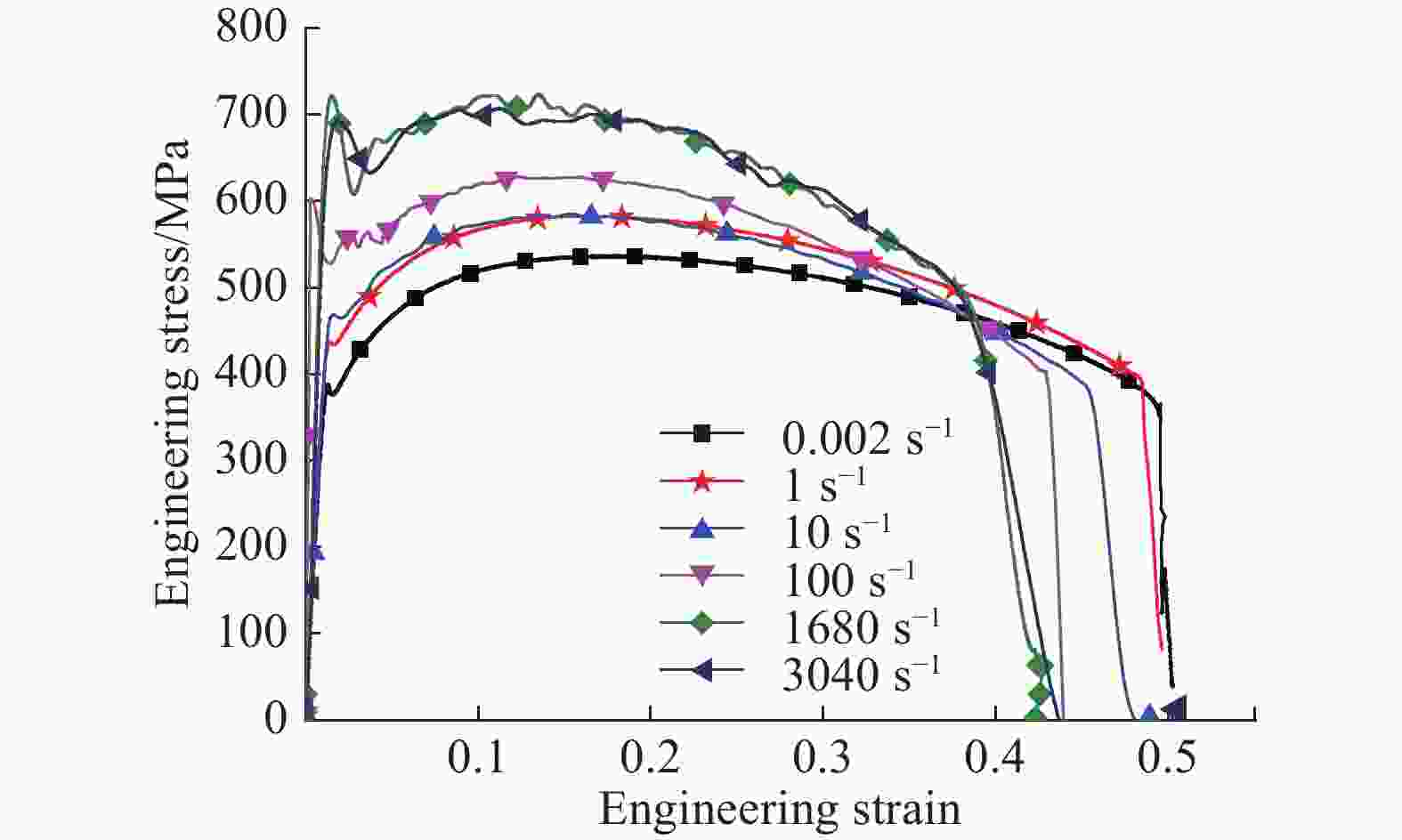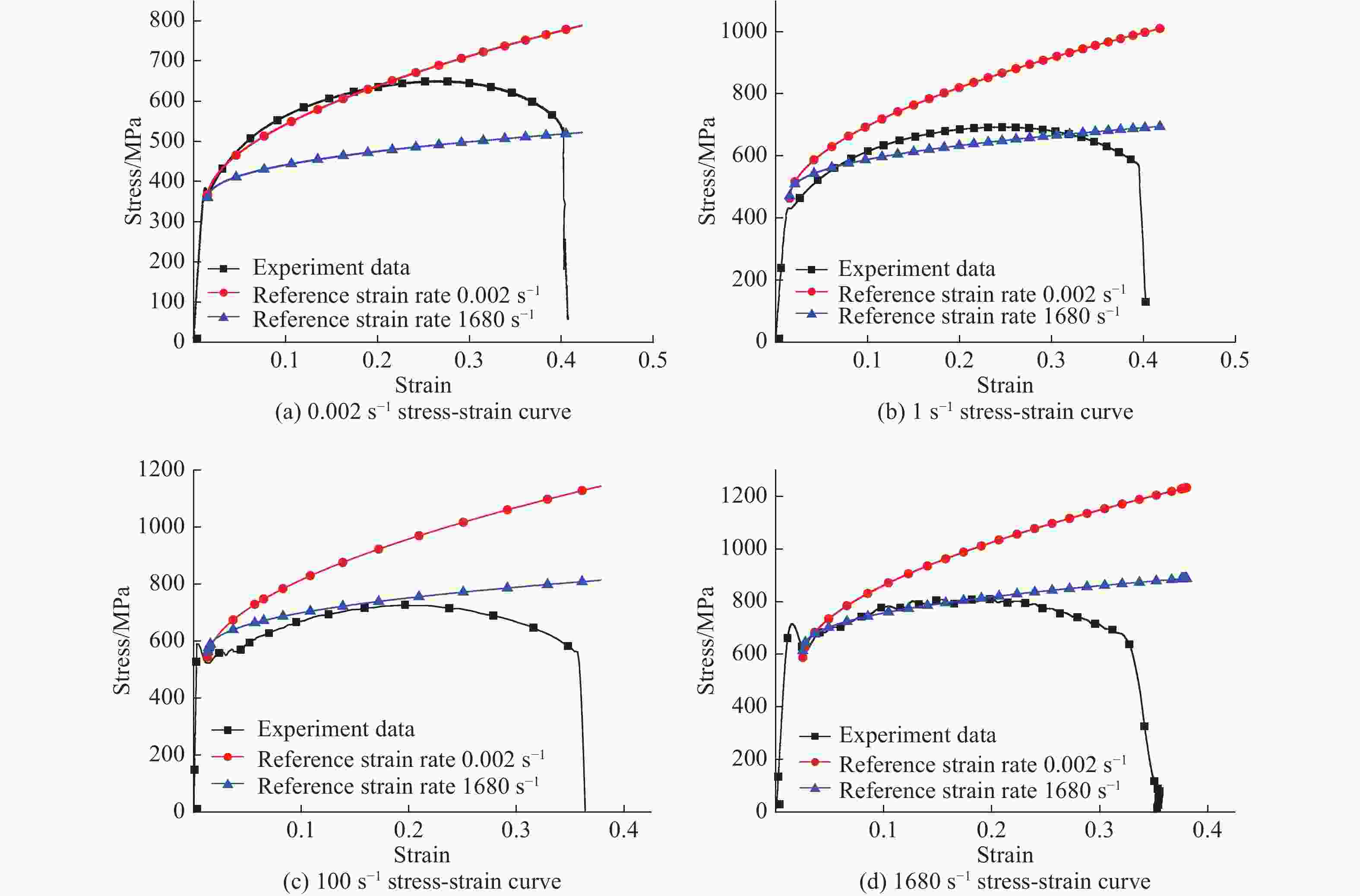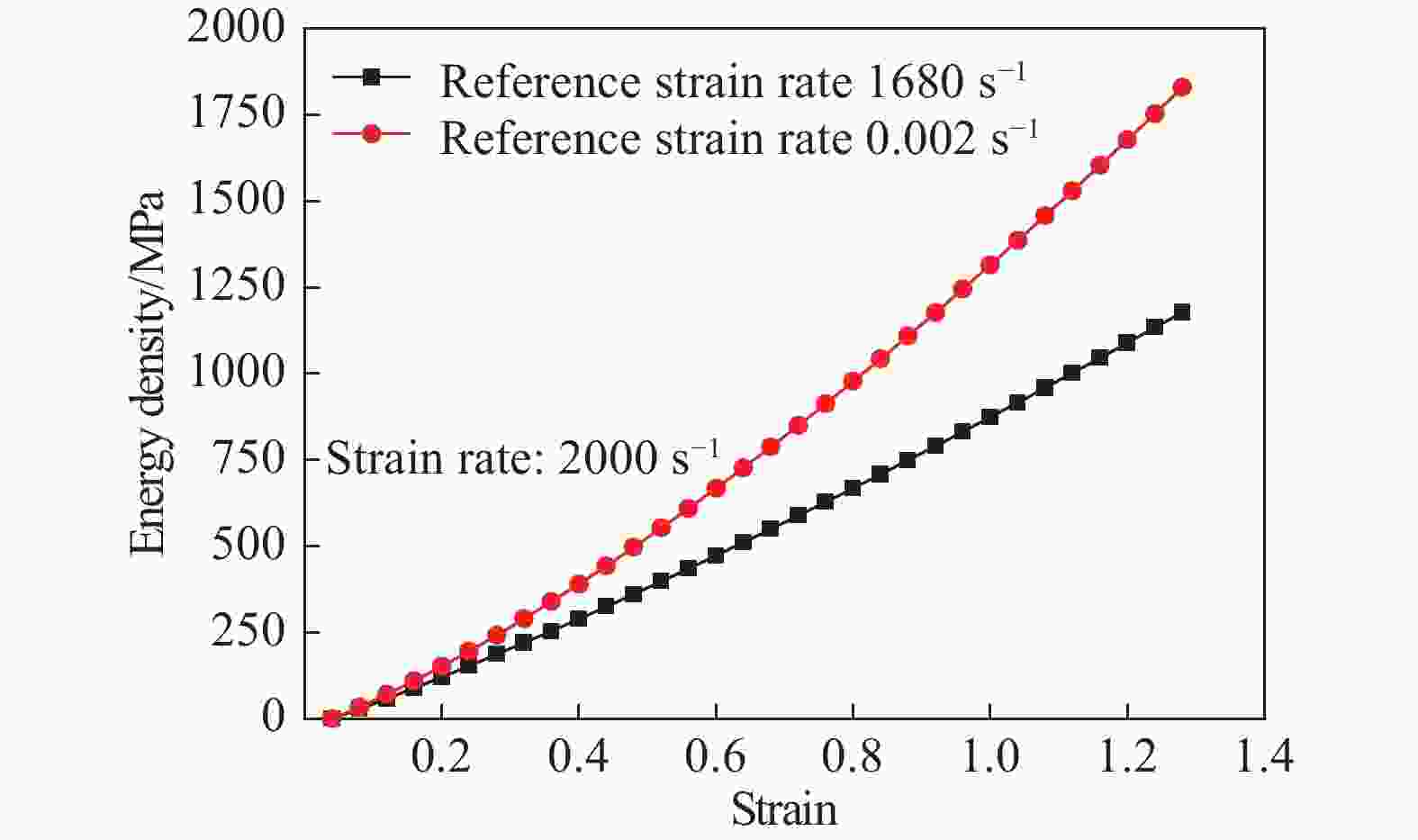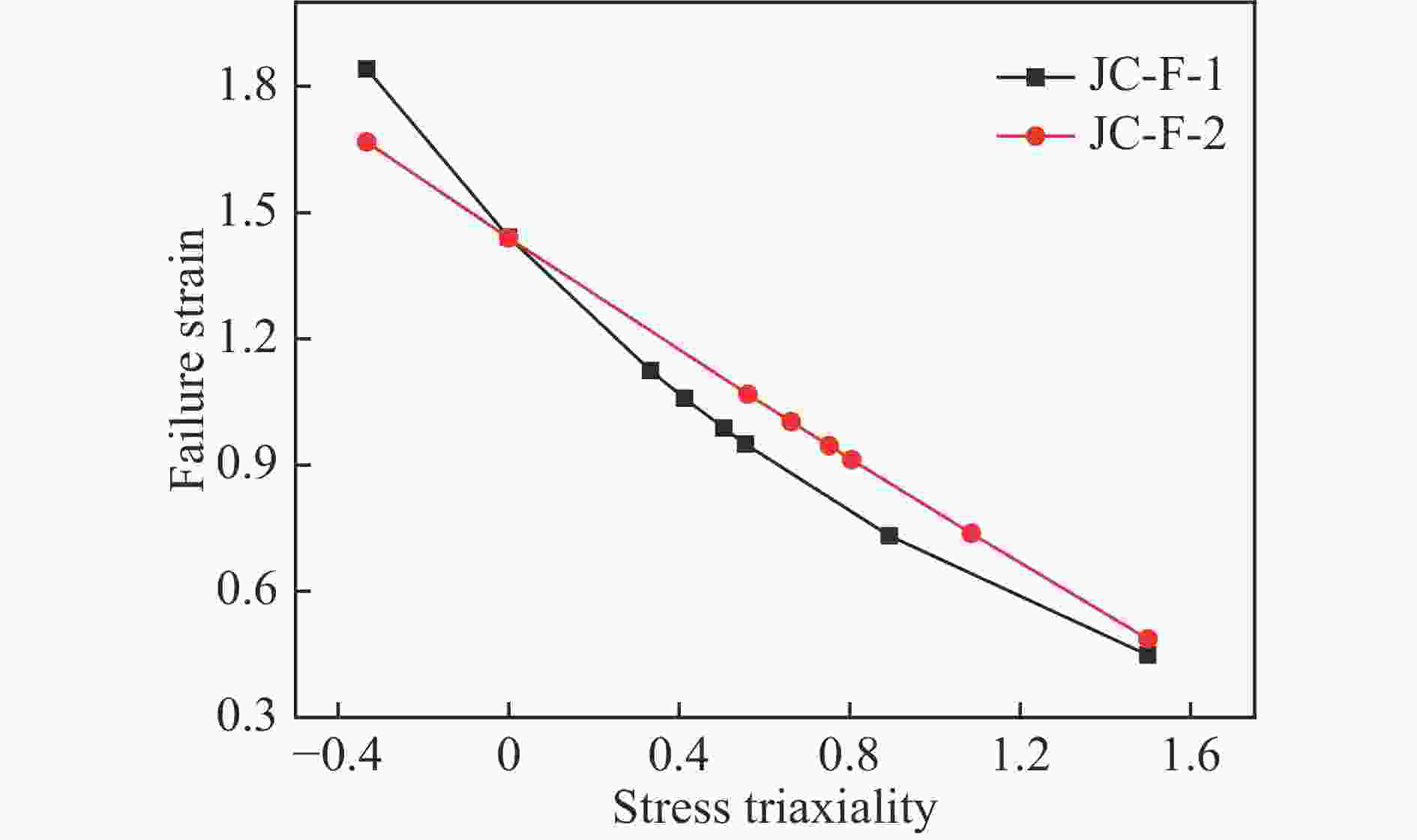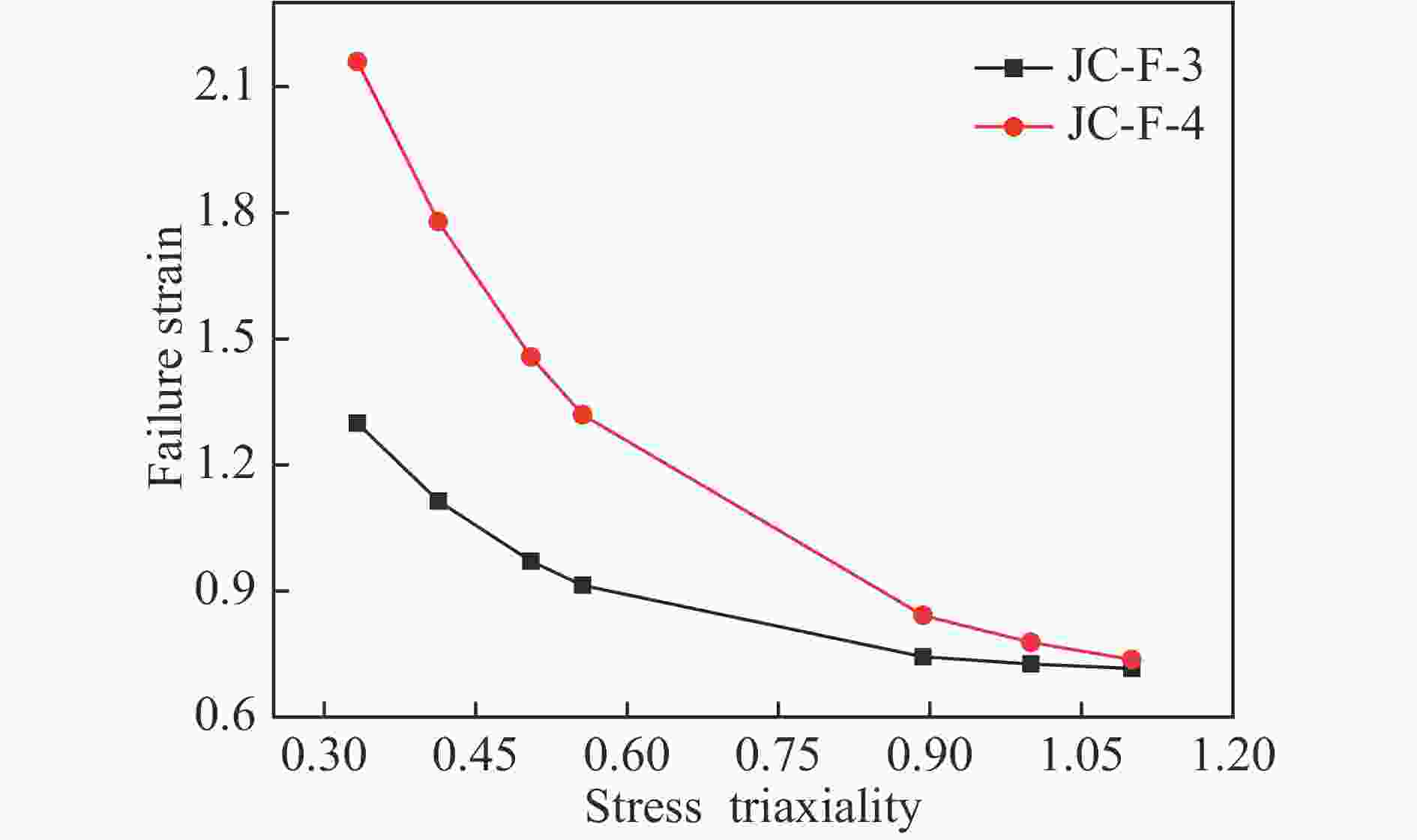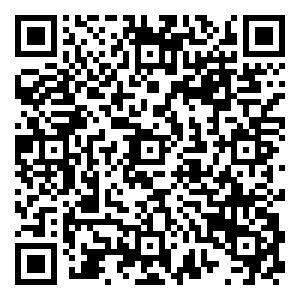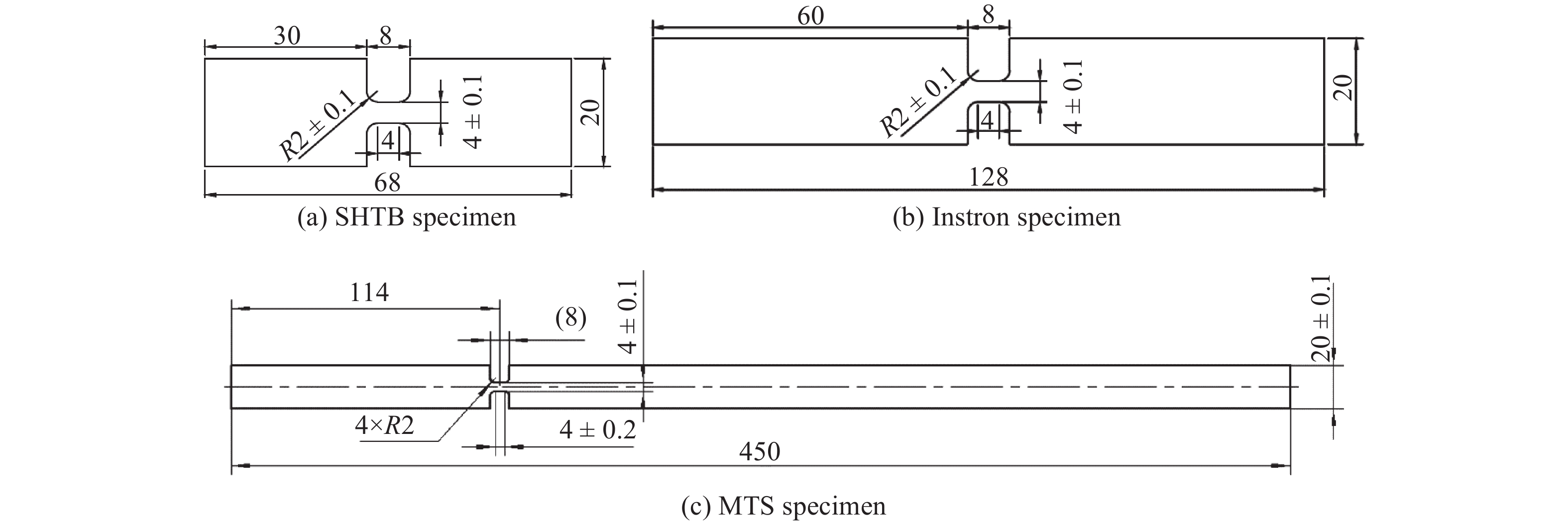Influence of Different Material Constants Fitting Method on Predicting Warhead Impacting Metal Targets
-
摘要: 弹靶侵彻仿真中材料参数对计算结果有着至关重要的影响。为寻求一套适用于弹靶侵彻仿真计算的材料参数拟合方法,借助前期开展的靶板材料动态力学性能试验、靶板材料断裂试验,通过不同拟合方法依次得到不同的JC本构模型及失效模型参数,依据试验建立有限元计算模型,将数值计算结果与试验结果进行对比。结果表明:(1)对于同一材料的力学性能试验,采用不同的拟合方法可得到不同的JC本构、JC失效参数,二者会对弹靶仿真结果造成一定影响;(2)在不考虑温度软化项的前提下,采用高应变率作为参考应变率进行拟合能更加准确地表征材料在高应变率下的应力-应变关系,更加适用于弹靶侵彻强瞬态、高应变率作用过程仿真;(3)对于同一JC本构模型,采用平均应力三轴度拟合的JC失效模型较采用初始应力三轴度拟合的JC失效模型所得战斗部剩余速度计算结果偏小,仅采用拉伸试件结果拟合的JC失效模型较采用扭转、拉伸试件结果拟合的JC失效模型所得战斗部剩余速度计算结果偏小。Abstract: Material constants played a significant role in the numerical prediction of warhead impacting metal targets, in order to obtain a set of valuable material constants fitting methods, JC strength model and JC failure model constants were acquired by different fitting method based on material mechanical properties and failure experiments. Simulation results were compared with experiment outcome in which different nose warhead penetrated different thickness metal plates, and it indicated: (1) simulation results could be distinct using JC strength model and JC failure mode constants from different fitting methods for the same material mechanical property tests; (2) JC strength model constants fitting by stress-strain curves using high reference strain rate were suitable for the numerical predicting warhead penetrating metal plates; (3) JC failure model constants fitting by initial stress triaxiality or average stress triaxiality had few influence on calculation results. This research could provide assistance for the material constants fitting method in numerical simulation.
-
Key words:
- material constants /
- constants fitting /
- JC strength model /
- JC failure model /
- stress triaxiality /
- penetration
-
表 1 不同试件类型失效应变取值
Table 1. Failure strain of different specimens
Specimen Stress triaxiality Failure strain ${\varepsilon _{\rm{f}}}$ Initial stress triaxiality Average stress triaxiality Compression –0.333 Torsion 0.000 0.0006 1.340 Smooth 0.333 0.562 1.273 R=18 mm 0.413 0.663 1.140 R=8 mm 0.505 0.752 1.045 R=6 mm 0.556 0.805 0.990 R=2 mm 0.893 1.085 0.791 表 2 JC失效模型参数拟合结果
Table 2. JC failure model constants
表 3 尖头战斗部穿甲8 mm厚Q345B钢金属板仿真计算结果与试验结果对比
Table 3. Comparison between experimental results and simulation results for sharp nosed warhead penetrating 8 mm thick Q345B steel targets
Material model Impact velocity/(m·s–1) Residual velocity/(m·s–1) Strength model Failure model Experiment Simulation Low reference strain rate JC-F-1 208 185 180 Low reference strain rate JC-F-2 208 185 177 High reference strain rate JC-F-1 208 185 184 High reference strain rate JC-F-2 208 185 183 Low reference strain rate JC-F-3 208 185 180 Low reference strain rate JC-F-4 208 185 174 High reference strain rate JC-F-3 208 185 182 High reference strain rate JC-F-4 208 185 178 表 4 尖头战斗部穿甲15 mm厚Q345B钢金属板仿真计算结果与试验结果对比
Table 4. Comparison between experimental results and simulation results for sharp nosed warhead penetrating 15 mm thick Q345B steel targets
Material model Impact velocity/(m·s–1) Residual velocity/(m·s–1) Strength model Failure model Experiment Simulation Low reference strain rate JC-F-1 273 216 204 Low reference strain rate JC-F-2 273 216 202 High reference strain rate JC-F-1 273 216 212 High reference strain rate JC-F-2 273 216 212 Low reference strain rate JC-F-3 273 216 194 Low reference strain rate JC-F-4 273 216 181 High reference strain rate JC-F-3 273 216 201 High reference strain rate JC-F-4 273 216 194 表 5 钝头战斗部穿甲15 mm厚Q345B钢金属板仿真计算结果与试验结果对比
Table 5. Comparison between experimental results and simulation results for blunt warhead penetrating 15 mm thick Q345B steel targets
Material model Impact velocity/(m·s–1) Residual velocity/(m·s–1) Strength model Failure model Experiment Simulation Low reference strain rate JC-F-1 273 163 75 Low reference strain rate JC-F-2 273 163 50 High reference strain rate JC-F-1 273 163 174 High reference strain rate JC-F-2 273 163 172 Low reference strain rate JC-F-3 273 163 55 Low reference strain rate JC-F-4 273 163 0 High reference strain rate JC-F-3 273 163 171 High reference strain rate JC-F-4 273 163 156 -
[1] SCHEFFER D R, ZUKA J A. Practical aspects of numerical simulation of dynamic events material interfaces [J]. International Journal of Impact Engineering, 2000, 24(8): 821–842. doi: 10.1016/S0734-743X(00)00003-8 [2] ZUKA J A. Practical aspects of numerical simulations of dynamic events: effects of meshing [J]. International Journal of Impact Engineering, 2000, 24(9): 925–945. doi: 10.1016/S0734-743X(00)00012-9 [3] JOHNSON G R, COOK W H. A constitutive model and data for metals subjected to large strains, high strains rates and high temperature [C]//Proceedings of the Seventh International Symposium on Ballistics. Netherland, 1983. [4] BØRVIK T, HOPPERSTAD O S, BERSTAD T, et al. A computational model of viscoplasticity and ductile damage for impact and penetration [J]. European Journal of Mechanics Solids, 2001, 20(5): 685–712. doi: 10.1016/S0997-7538(01)01157-3 [5] GUPTA N K, IQBAL M A. Experiment and numerical studies on the behavior of thin aluminum plates subjected to impact by blunt and hemispherical-nosed projectile [J]. International Journal of Impact Engineering, 2006, 32(12): 1921–1944. doi: 10.1016/j.ijimpeng.2005.06.007 [6] BØRVIK T, HOPPERSTAD O S. Numerical simulation of plugging failure in ballistic penetration [J]. International Journal of Solids and Structures, 2001, 38(25): 6241–6264. [7] BAO Y B, WIERZBICKI T. On fracture locus in the equivalent strain and stress triaxiality space [J]. International Journal of Mechanical Sciences, 2004, 46(12): 81–98. [8] GILIOLI A, WIERZBICKI T. Predicting ballistic impact failure of aluminium 6061-T6 with the rate-independent Bao-Wierzbicki fracture model [J]. International Journal of Impact Engineering, 2015, 76(15): 207–220. [9] TENG X, WIERZBICKI T. Evaluation of six fracture models in high velocity perforation [J]. Engineering Fracture Mechanics, 2016, 73(12): 1653–1678. [10] 陈刚. 半穿甲战斗部弹体穿甲效应数值模拟和实验研究[D]. 绵阳: 中国工程物理研究院, 2006.CHEN G. Numerical and experimental investigation on penetration effects of semi-armor-piercing warhead [D]. Mianyang: China Academy of Engineering Physics, 2006. [11] 姚熊亮, 徐小刚. 船用917钢抗冲击性能试验 [J]. 中国造船, 2004, 45(4): 35–41. doi: 10.3969/j.issn.1000-4882.2004.04.006YAO X L, XU X G. The experiment research of steel 917 under impact load [J]. Ship Building of China, 2004, 45(4): 35–41. doi: 10.3969/j.issn.1000-4882.2004.04.006 [12] 李营. 液舱防爆炸破片侵彻作用机理研究 [D]. 武汉: 武汉理工大学, 2014.LI Y. Study of anti-blast fragment penetration mechanism in liquid tank [D]. Wuhan: Wuhan University of Technology, 2014. [13] 伍星星, 孟利平, 刘建湖, 等. 大质量战斗部穿甲数值仿真对材料断裂极限参数确定分析[C]//第十五届战斗部与毁伤会议集. 北京, 2017.WU X X, MENG L P, LIU J H, et al. Parameter determination analysis of material fracture limit by numerical simulation armor piercing in mass warhead [C]//The 15th Warhead Damage Conference. Beijing, 2017. [14] BØRVIK T, HOPPERSTAD O S. On the influence of stress triaxiality and strain rate on the behavior of a structural steel. Part II. numerical study [J]. European Journal of Mechanics A-Solids, 2003, 22(1): 15–32. doi: 10.1016/S0997-7538(02)00005-0 [15] 陈继恩. 基于应力三轴度的材料失效研究 [D]. 武汉: 华中科技大学, 2012.CHEN J E. Research of material failure basic on stress triaxiality [D]. Wuhan: Huazhong University of Science and Technology, 2012. [16] 孟利平. 应变率和应力三轴度对船用钢变形和断裂的影响研究 [D]. 无锡: 中国船舶科学研究中心, 2016.MENG L P. Study on the influence of strain rate and stress triaxiality on deformation and fracture of marine steel [D]. Wuxi: China Ship Science Research Center, 2016. [17] 谢凡, 张涛, 陈继恩, 等. 应力三轴度的有限元计算修正 [J]. 爆炸与冲击, 2012, 32(1): 8–14. doi: 10.3969/j.issn.1001-1455.2012.01.002XIE F, ZHANG T, CHEN J E, et al. Updating of the stress triaxiality by finite element analysis [J]. Explosion and Shock Waves, 2012, 32(1): 8–14. doi: 10.3969/j.issn.1001-1455.2012.01.002 [18] 伍星星, 张伦平, 刘建湖, 等. 不同类型战斗部穿甲不同金属板试验与理论分析 [C]//第十五届战斗部与毁伤会议集. 北京, 2017.WU X X, ZHANG L P, LIU J H, et al. Experimental and theory analysis on different nosed warhead penetrating different thickness metal [C]//The 15th Warhead Damage Conference. Beijing, 2017. -






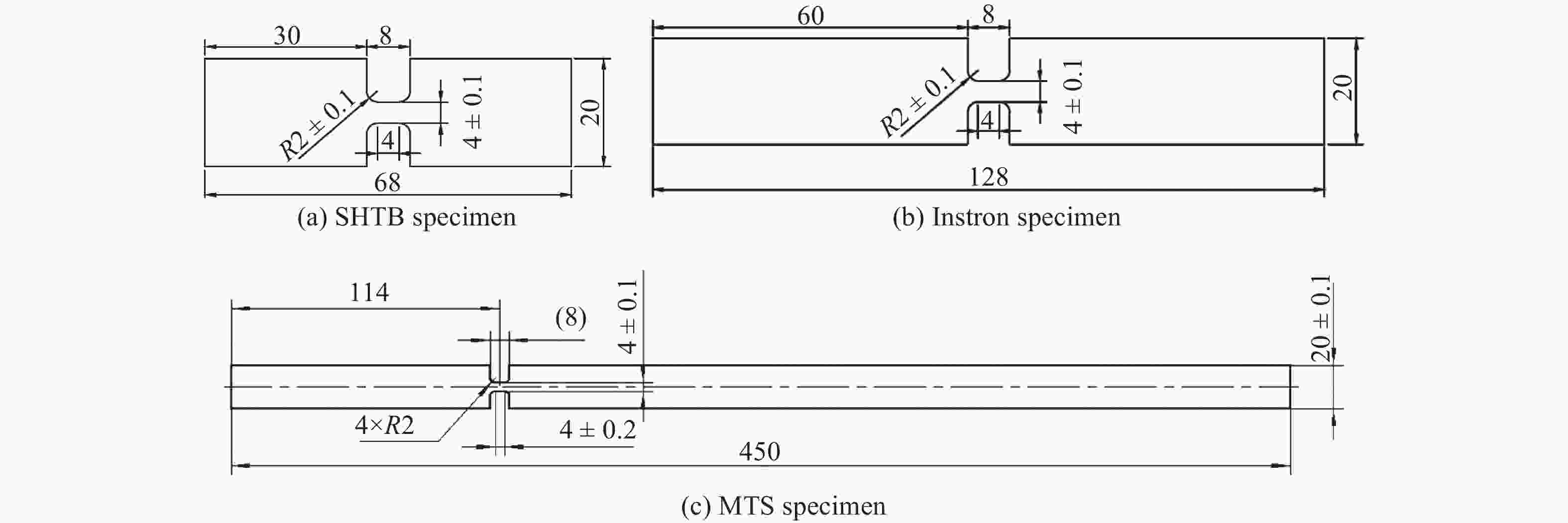
 下载:
下载:
